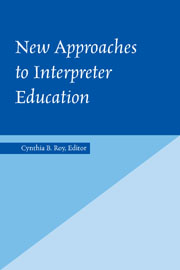Cynthia B. Roy, Editor
|
View the table of contents. Read an excerpt. Read a review. |
$45.00s print edition $45.00 e-book |
Interpreter Education, Volume 3
The complex nuances of interpreting generate a continuous demand for detailed curricula to enhance instruction. The latest addition to the Interpreter Education series New Approaches to Interpreter Education expands the tools available to instructors with seven new, vital chapters on new curricula and creative teaching methods. Series editor Cynthia B. Roy, Associate Professor in the Department of Interpretation at Gallaudet University in Washington, DC, called upon the expertise of nine other renowned interpreter educators to create this incisive collection.
David Sawyer begins the volume with the foreword in which he emphasizes the importance of integrating theory and practice in order to improve the quality of interpreter education. Risa Shaw, Steven D. Collins, and Melanie Metzger follow with a description of the process for establishing a bachelor of arts program in interpreting at Gallaudet University distinct from the already existent masters program. that outlines the positive results from the use of a discourse-oriented curriculum for educating interpreters. In the second chapter, Claudia Angelelli outlines the bottom-line principles for teaching effective health-care interpreting, postulating a model that depends upon the development of skills in six critical areas: cognitive-processing, interpersonal, linguistics, professional, setting-specific, and sociocultural.
Helen Slatyer delineates the use of an action research methodology in the third chapter to establish a curriculum for teaching ad hoc interpreters of languages used by small population segments in Australia. In the fourth chapter, Jemina Napier blends three techniques for instructing signed language interpreters in Australia: synthesizing sign and spoken language interpreting curricula; integrating various interpreting concepts into a theoretical framework; and combining online and face-to-face instruction. David Sawyer adopts a holistic perspective in his chapter on training interpreters in less frequently taught language combinations, to offer models and methods for interpreters in areas such as the Middle East, Africa, and Asia. Doug Bowen-Bailey describes how to apply theories of discourse-based interpreter education in specific contexts by producing customized videos. Finally, Mary Mooney addresses issues of ethnicity, cultural awareness, and intercultural communication skills among interpreters, interpreter educators, and interpreter education programs in the sign language community, to enhance competency for working within these diverse communities. All of these innovative concepts for creating curricula for interpreter training combine to ensure New Approaches to Interpreter Education as the state-of-the-art standard in this intricate discipline.
Cynthia B. Roy is a retired professor in the Department of Interpretation and Translation at Gallaudet University, where she directed the BA program and the PhD program. She is also a nationally certified American Sign Language–English interpreter specializing in community interpreting.
Print Edition: ISBN 978-1-56368-297-1, 6 x 9 casebound, 148 pages, figures, tables, index
$45.00s
E-Book: ISBN 978-1-56368-380-0
$45.00
To order by mail, print our Order Form or call:TEL 1-800-621-2736; (773) 568-1550 8 am - 5 pm CST
TTY 1-888-630-9347
FAX 1-800-621-8476; (773) 660-2235
